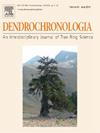Consistent summer temperature signals in a latewood blue intensity network from the upper tree line in the Caucasus
IF 2.3
3区 农林科学
Q1 FORESTRY
引用次数: 0
Abstract
Climate variability in the Caucasus region significantly influences tree growth in alpine tree line ecotones. However, long-standing human land-use history disrupted the natural equilibrium between montane forests and alpine meadows. These complex vegetation dynamics may cause traditional proxies such as tree-ring width (TRW) to display a weak climate signal, limiting their utility for understanding growth-climate relationships. To address these challenges, we established a multispecies network of seven tree ring width index (TRWI) and seven latewood blue intensity (LWBI) chronologies from three coniferous species (Picea orientalis, Abies nordmanniana and Pinus sylvestris) at current tree line sites (1900–2300 masl) in the Greater and Lesser Caucasus. Our results show that almost all the LWBI site chronologies demonstrate consistent and stable correlation with summer temperature (June-August). In contrast, corresponding TRWI chronologies reveal much weaker correlations with temperature, mainly with previous winter and spring. TRWI moderately responds to precipitation during the summer (JJA) while LWBI does not show any significant response to precipitation. The weaker and less consistent temperature signals in TRWI chronologies suggest additional influence of precipitation, non-climatic factors and local disturbance events on TRWI. Principal component analysis reveals a robust common signal in the LWBI network. First principal components from both proxies correlate with summer temperatures, although correlation is much higher for LWBI than for TRWI. The stable and consistent relationship between LWBI and summer temperature in different frequency domains indicates high potential of this proxy for annually resolved climate reconstructions at a regional level, which would be new for the Lesser Caucasus region.
高加索地区林木线上方的晚木蓝强度网络中一致的夏季温度信号
高加索地区气候变率对高山林木线过渡带树木生长有显著影响。然而,长期的人类土地利用历史破坏了山地森林和高山草甸之间的自然平衡。这些复杂的植被动态可能导致树木年轮宽度(TRW)等传统指标显示出微弱的气候信号,从而限制了它们在理解生长-气候关系方面的效用。为了应对这些挑战,我们在大高加索和小高加索地区现有的林木线站点(1900-2300 masl)建立了一个多物种网络,包括7个树木年轮宽度指数(TRWI)和7个晚木蓝强度(LWBI)年代学,这些年代学来自3种针叶林物种(云杉、北冷杉和西尔韦斯松)。结果表明,几乎所有LWBI站点年表都与夏季气温(6 - 8月)具有一致且稳定的相关性。相比之下,相应的TRWI年表显示与温度的相关性要弱得多,主要与之前的冬季和春季有关。TRWI对夏季降水有中等响应,而LWBI对降水没有显著响应。TRWI年表中较弱且不一致的温度信号表明降水、非气候因素和局地扰动事件对TRWI有额外的影响。主成分分析揭示了LWBI网络中存在鲁棒的公共信号。第一,两个代理的主成分与夏季气温相关,尽管LWBI的相关性比TRWI高得多。LWBI与夏季温度在不同频率域的稳定一致关系表明,该方法在区域水平上具有很高的潜力,这对于小高加索地区来说是新的。
本文章由计算机程序翻译,如有差异,请以英文原文为准。
求助全文
约1分钟内获得全文
求助全文
来源期刊

Dendrochronologia
FORESTRY-GEOGRAPHY, PHYSICAL
CiteScore
5.50
自引率
13.30%
发文量
82
审稿时长
22.8 weeks
期刊介绍:
Dendrochronologia is a peer-reviewed international scholarly journal that presents high-quality research related to growth rings of woody plants, i.e., trees and shrubs, and the application of tree-ring studies.
The areas covered by the journal include, but are not limited to:
Archaeology
Botany
Climatology
Ecology
Forestry
Geology
Hydrology
Original research articles, reviews, communications, technical notes and personal notes are considered for publication.
 求助内容:
求助内容: 应助结果提醒方式:
应助结果提醒方式:


